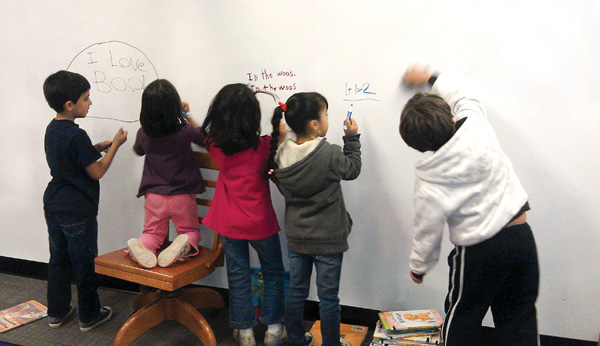
Children working on an “idea paint wall” in the library,
Cale Elementary School, Charlottesville, VA.
Join Pam Moran and Ira Socol on Twitter Oct 22 at 7 pm ET for #engchat on the role of libraries
When it comes to libraries, educators Ira Socol and Pam Moran are very clear—it’s imperative that these institutions evolve in today’s technologically-driven world or risk fading into irrelevancy.
“I don’t think the physical space for libraries should ever go away,” says Socol, a special education technology scholar at Michigan State University’s College of Education in East Lansing. “But by the same token, every time technology has changed, the shape and form of libraries have changed.”
Socol and Moran, superintendent of the Albemarle County Public Schools in Charlottesville, VA, will tackle the shifting role of libraries in “Triggering Transformation” their “unkeynote” presentation at School Library Journal’s Leadership Summit. At the October 26–27 event in Philadelphia, the two will urge educators to consider the current digital environment and how it affects the way students and other patrons connect with information for both education and pleasure.

Ira Socol
Libraries, in particular, must develop the capacity to function as kinetic centers of learning and activity, where people come to engage, absorb, and create, according to Moran and Socol. Media specialists who understand that, say the two, will continue to play an important part in student learning. Those who see their role as simply manning the circulation desk are very likely to find their jobs at risk in a new era of education.
“Libraries have to be places where they’re making and searching content and also places where they engineer, sketch, and design themselves,” says Moran. “And librarians play an important role in doing that with young people.”
The potential risk, according to Socol, is that patrons will find and create libraries of their own—choosing spaces where they can engage and connect. One example, he says, is New York’s 24-hour Apple Store on Fifth Avenue, which you’ll find abuzz with activity at 2 a.m. Then there’s the local coffee shop where Socol has seen students gather to read and do their work.

“You see people wanting to be together,” he says. “And it’s not just about access to technology, it’s about people being together and sharing. So libraries have to rethink what they do. My town has a wonderful library that doesn’t attract teenagers because it filters the Internet in a way teens won’t tolerate. So the coffee shop becomes their library.”
To Moran it’s a simple scenario of patrons voting with their feet on whether a library works for them or not. That could be an adult choosing to go to a chain bookstore instead of the local branch of their public library, or a high school student who perceives the media center as a staid, dusty tomb. “In the schools where libraries are zones where kids are engaged with each other versus places where you have a ‘shush’ model, we have kids that skip classes to go to the library,” she says.
Neither Socol nor Moran thinks that libraries need disappear. In fact, they believe their place as a center for discovery and learning can flourish. The key, they say, is for librarians to understand the imperative that they’re competing for users’ attention—and that they find a way to not just recommend the next good read to users, but help patrons of all ages connect to material to enable a deeper understanding of the world.
“We have to acknowledge that if we try to maintain the status quo of our past, we could see the loss of libraries,” says Moran.


Libraries of today have gone beyond bricks and mortals, but as the world changes, users demands and responses to libraries change, librarians must take cognisance of this to remain relevant in the technology driven world